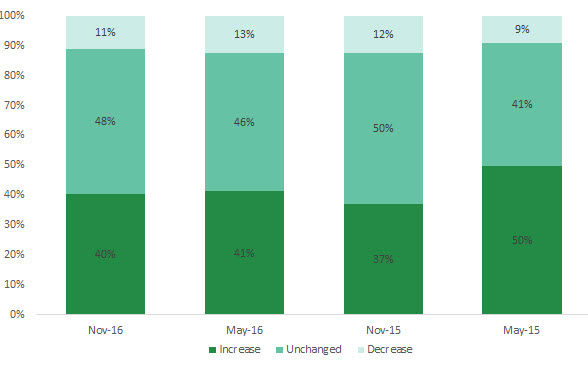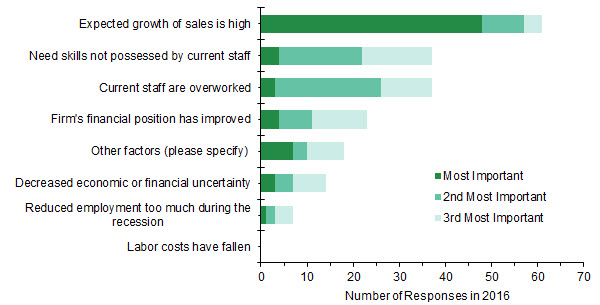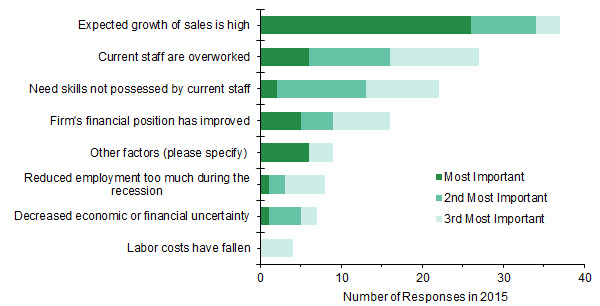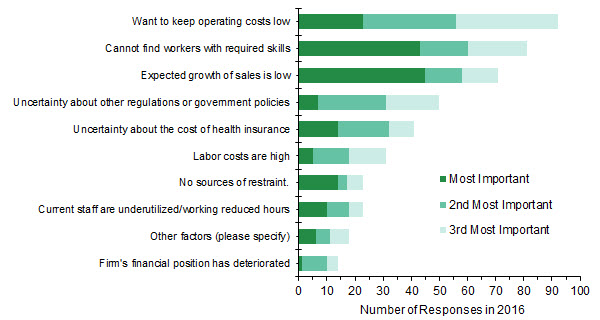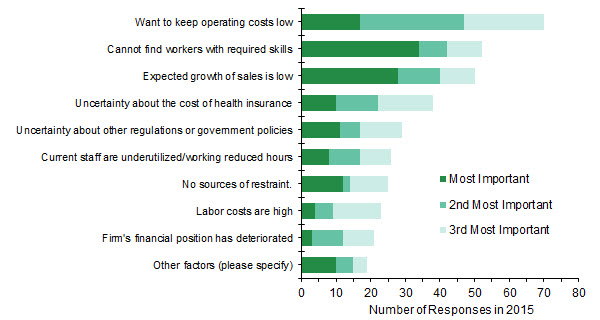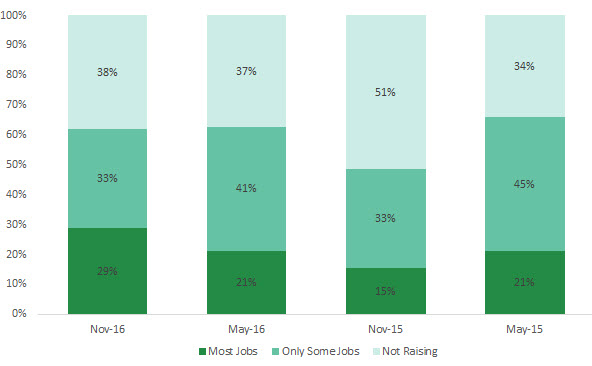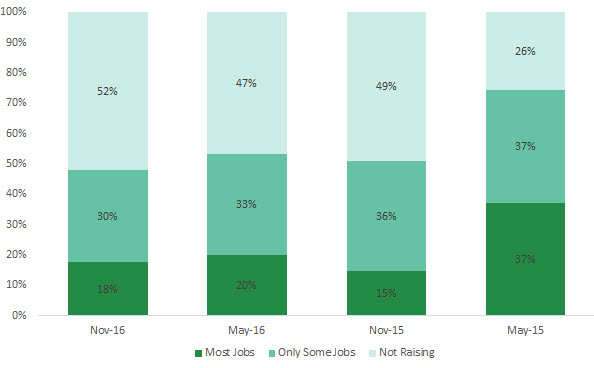Updated Survey on Hiring and Wages
Earlier this year, we reported the results of a special survey on hiring and wages. A similar survey was conducted in November. In addition to asking employers about their plans for hiring, the November survey asked participants why they might or might not be increasing employment and the role of wages in attracting and retaining employees.
The results from our most recent survey on hiring and wages indicated that business expectations for hiring over the next 12 months remain about on pace with the expectations reported earlier in 2016. Meanwhile, wage increases to attract new employees seemed more widespread with this most recent survey. Wage increases for retention purposes, on the other hand, were about on par with the results of the previous two surveys but differed markedly from the result in May 2015.
Employment
We heard from 188 businesses in response to our November 2016 survey on hiring and wages, of which 40 percent said that they were planning to increase employment over the next 12 months. On the other hand, 11 percent said that they were planning to decrease employment over the same period, and the remaining participants indicated no change in employment.
As can be seen from the chart below, results in May and November of 2016 are remarkably similar but differ slightly from the results in 2015. In November 2015, only 37 percent of employers polled said they were planning on hiring over the next year. In May 2015, however, half of the respondents indicated plans to increase employment.
Both in the most recent survey and in the November 2015 survey, participants who intended to increase employment were asked to give the top three reasons for expecting to raise employment. The charts below show that the most important factor in both survey periods was that the expected growth of sales was high; that response received both the highest number of votes for “most important” and the greatest number of combined votes. The second and third most commonly selected answers were the same in both surveys but flipped in order. In the most recent survey, “need skills not possessed by current staff” had very slightly more total responses than “current staff are overworked.”
Just considering the "most important" selections (the dark green segments) in the November 2016 survey, the second most selected answer given was "other factors."In the open-ended comment box that followed, some of the answers given included replacing staff that recently left, preparing for upcoming retirements, and business expansion into new markets. Last November, the "other factors" answer was also the second most popular response for "most important." From that survey, the write-in answers were more focused around adding capacity, expanding product lines, and expansion into new markets.
From the very first chart, recall that the percent of survey responses from this November who indicated an expected decrease in employment was 11 percent, compared to 12 percent in November 2015. Additionally, 48 percent of participants said they had no plans to change employment this November, and 50 percent said the same last November. Those participants were asked to select the top three factors restraining their hiring plans. The charts below show the results of that question for this November and last November.
The above shows that, when asked to select reasons for not hiring, the three most popular answers were the same in both years when you consider the combined number of responses. However, if you consider just the "most important" factor (the dark green segments), this year the top response was that expected sales were low, while last year the most important factor was difficulty finding workers with the required skills.
Wages
The first question in the survey about wages asked those who are actively seeking to hire workers right now if they are raising starting wages for most positions, only select positions, or not raising starting wages at all. The below chart shows the responses to this question for the past several surveys.
As you can see in the chart above, in the current survey period, 29 percent of respondents answered that they were raising starting wages for most categories, which was the largest share to give that answer over the last four surveys. If you combine the responses for "most jobs" and "only some jobs," the current survey looks very similar to the ones in May 2016 and May 2015, all of which were considerably higher than in November 2015.
Lastly, the survey asked all participants if they are making any changes to wages to retain existing employees. The possible answers were the same as the prior question on starting wages. As is clear from the chart below, firms who responded to the survey were more likely to raise wages for new employees than for existing employees. Only 18 percent of survey participants indicated wage increases for retention purposes for most jobs, which was somewhat similar to the results of the previous two surveys. In May 2015, however, there were markedly more responses indicating wage increases for most current job holders.
Have a question or comment about this article? We'd love to hear from you!
Views expressed are those of the authors and do not necessarily reflect those of the Federal Reserve Bank of Richmond or the Federal Reserve System.


